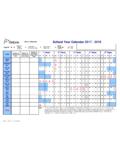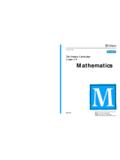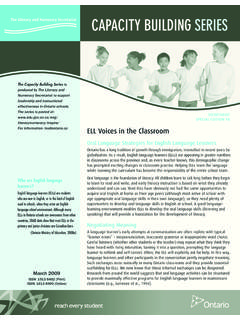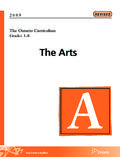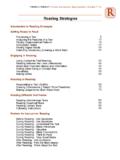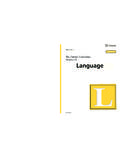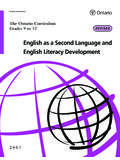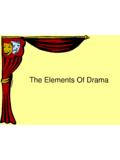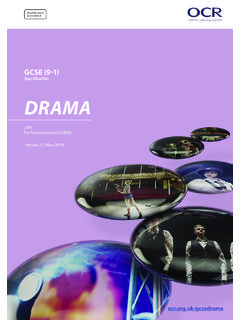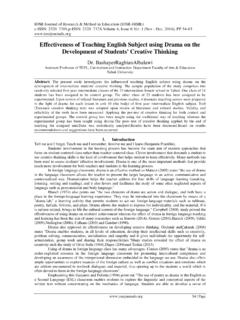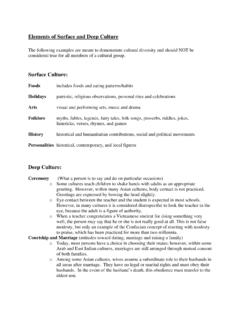Transcription of The Ontario Curriculum, Grades 9 and 10: The Arts, 2010
1 TheOntarioCurriculumGrades9and102010 REVISEDTheArtsINTRODUCTION 3 Secondary Schools for the Twenty-First Century .. 3 The Importance of the Arts Curriculum .. 3 Ideas Underlying the Arts Curriculum .. 5 Roles and Responsibilities in the Arts Program .. 5 Attitudes in the Arts .. 7 THE PROGRAM IN THE ARTS9 Overview of the Program .. 9 Curriculum Expectations .. 12 Strands in the Arts Curriculum ..14 The Creative Process.
2 14 The Critical Analysis Process .. 16 ASSESSMENT AND EVALUATION OF STUDENT ACHIEVEMENT21 Basic Considerations .. 21 The Achievement Chart for the Arts: Grades 9 12 .. 24 Information on the Achievement Chart .. 26 SOME CONSIDERATIONS FOR PROGRAM PLANNING IN THE ARTS29 Instructional Approaches .. 29 Planning Arts Programs for Students With Special Education Needs .. 30 Program Considerations for English Language Learners .. 32 Environmental Education and the Arts .. 35 Healthy Relationships and the Arts .. 36 Equity and Inclusive Education in the Arts Program.
3 36 Multiple Literacies in the Arts .. 38 Literacy, Mathematical Literacy, and Inquiry/Research Skills .. 39 Critical Thinking and Critical Literacy in the Arts .. 40 The Role of the School Library in the Arts Program .. 41 The Role of Information and Communications Technology in the Arts Program .. 42 Une publication quivalente est disponible en fran ais sous le titre suivant : Le curriculum de l Ontario , 9eet 10eann e ducation artistique, 2010 This publication is available on the Ministry of Education s website, at The Ontario Skills Passport and Essential Skills.
4 43 Career Education .. 43 Cooperative Education and Other Forms of Experiential Learning .. 43 Planning Program Pathways and Programs Leading to a Specialist High Skills Major .. 44 Health and Safety in the Arts Program .. 44 Ethics in the Arts Program .. 45 COURSESDANCE49 Overview .. 49 Dance, Grade 9, Open (ATC1O) .. 51 Dance, Grade 10, Open (ATC2O) .. 58 DRAMA65 Overview .. 65 Drama, Grade 9, Open (ADA1O) .. 67 Drama, Grade 10, Open (ADA2O) .. 74 INTEGRATED ARTS 81 Overview .. 81 Integrated Arts, Grade 9 or 10, Open (ALC1O/ALC2O).
5 82 MEDIA ARTS89 Overview .. 89 Media Arts, Grade 10, Open (ASM2O) .. 91 MUSIC 99 Overview .. 99 Music, Grade 9, Open (AMU1O) .. 101 Music, Grade 10, Open (AMU2O) .. 109 VISUAL ARTS117 Overview .. 117 Visual Arts, Grade 9, Open (AVI1O) .. 119 Visual Arts, Grade 10, Open (AVI2O) .. 126 GLOSSARY1332 This document replaces The Ontario Curriculum, Grades 9 and 10: The Arts, 1999. Beginningin September 2010, all arts courses for Grades 9 and 10 will be based on the expectationsoutlined in this document.
6 SECONDARY SCHOOLS FOR THE TWENTY-FIRST CENTURY The goal of Ontario secondary schools is to support high-quality learning while givingindividual students the opportunity to choose programs that suit their skills and updated Ontario curriculum, in combination with a broader range of learning optionsoutside traditional classroom instruction, will enable students to better customize theirhigh school education and improve their prospects for success in school and in life. THE IMPORTANCE OF THE ARTS CURRICULUM Experiences in the arts dance, drama, media arts, music, and the visual arts play avaluable role in the education of all students.
7 Through participation in the arts, studentscan develop their creativity, learn about their own identity, and develop self-awareness,self-confidence, and a sense of well-being. Since artistic activities involve intense engage-ment, students experience a sense of wonder and joy when learning through the Arts, which can motivate them to participate more fully in cultural life and in other educationalopportunities. The arts nourish the imagination and develop a sense of beauty, while providing uniqueways for students to gain insights into the world around them.
8 All of the arts communi-cate through complex symbols verbal, visual, and aural and help students understandaspects of life in a variety of ways. Students gain insights into the human conditionthrough ongoing exposure to works of art for example, they can imagine what it wouldbe like to be in the same situation as a character in a play, an opera, or a painting, and tryto understand that character s point of view. They identify common values, both aestheticand human, in various works of art and, in doing so, increase their understanding of others and learn that the arts can have a civilizing influence on society.
9 In producing their own works, students communicate their insights while developing artistic skills and aesthetic judgement. Through studying works of art from various cultures, students deepen their appreciationof diverse perspectives and develop the ability to approach others with openness andflexibility. Seeing the works of art produced by their classmates also helps them learnabout, accept, and respect the identity of others and the differences among people. Theopenness that is fostered by study of the arts helps students to explore and appreciate theculture of diverse peoples in Canada, including First Nations and francophones.
10 Students3 INTRODUCTION4 THE Ontario CURRICULUM, Grades 9 AND 10|The Artslearn that people use the arts to record, celebrate, and pass on to future generations their personal and collective stories and the values and traditions that make us unique as in the arts involves students intellectually, emotionally, socially, and through the arts therefore fosters integration of students cognitive, emotional,sensory, and motor capacities, and enables students with a wide variety of learning stylesto increase their learning potential. For example, hands-on activities can challenge studentsto move from the concrete to the abstract, and the students learn that, while the arts canbe enjoyable and fulfilling, they are also intellectually rigorous disciplines.
